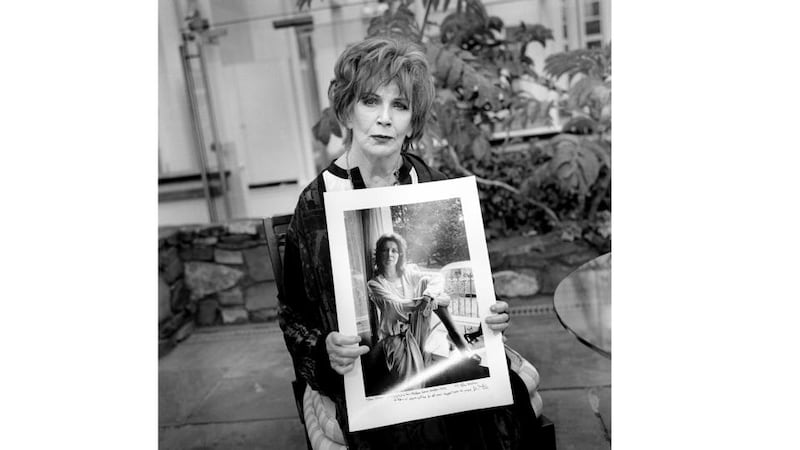My Own Unknown – Dragana Jurisic
Stray – Paul Gaffney
Oliver Sears Gallery, Dublin
★★★★★
Few people can have had as dramatic a beginning in photography as Dragana Jurisic, who was born in Slavonski Brod, then in Yugoslavia, now in Croatia.
Her family home was destroyed during the Croatian war of independence in 1991. Jurisic’s father, a keen amateur photographer, lost his entire photographic archive, thousands of prints and negatives. From that moment, he set his camera aside. The only photograph he took was “a perfunctory snapshot to record the damage for the insurance company,” Jurisic writes. “Where my father stopped, I started.” The camera “helped provide a semblance of control over an otherwise unpredictable world”.


Jurisic studied photography in Wales and is now based in Dublin. She has won a number of awards, bursaries and residences for her wide-ranging, almost novelistic approach. Her work is conceived as a series of chapters under the general heading My Own Unknown. The chapters adopt various strategies in exploring levels and facets of perception and identity – national, cultural and gender-related. Enduring preoccupations include loss, and the question of what is knowable about individuals.
One point of departure is L'Inconnue de la Seine, an unknown young woman who drowned in the Seine and whose serene death mask inspired many artists and writers, including Anaïs Nin and Albert Camus. Jurisic's 100 Muses chapter uses a plaster cast of the death mask. It becomes the recurrent face in Polaroids of nude female subjects, each of whom decided how she would be photographed and which image should represent her.
Another chapter, She Was So Beautiful, Like She Was Her Own Creator, documents Jurisic's attempt to trace the story of her aunt Gordana Cavic, a glamorous figure who left rural Yugoslavia in the 1950s and whose subsequent experiences involving false identities and espionage remain mysterious. Jurisic presents her careful, fruitful research in a series of illustrated notebooks that recall WG Sebald's approach to memoir, history and reflection.
There is much more to My Own Unknown, all rich and thoughtful.
In Stray, in the upstairs galleries, Paul Gaffney leads us along tracks and paths in a series of eerie, darklit photographs of woodland by night. Gaffney is influenced by the writer and philosopher Arnold Berleant, who emphasises the involving, engaging nature of artistic experience as opposed to the distanced, theoretical view of conventional aesthetic theory. For Berleant, landscape painting, say, draws us into its own reality over and above other, more abstract ways of analysing it.
Gaffney took the radical approach of wandering through a conifer forest on dark nights. There’s a silvery glitter to the more visible elements of his sumptuously dark images, which are dominated by dense, deep shadows and things we do not see. Those shadows inspire attentive wariness.
Gaffney has made a book of Stray. As with his earlier photobook, We Make the Path by Walking, it has been deservedly well received.
- Until July 28th, oliversearsgallery.com
Landscape Rising – Karl Burke, Mary Furlong, Kim Haughton and Joby Hickey
Solomon Fine Art, Dublin
★★★★
Landscape Rising, curated by former Observer Magazine picture editor Jennie Ricketts, presents an in-depth look at work by four photographic artists on several subjects. Landscape is the common, but not necessarily the most important, thread.
Karl Burke addresses the Rising, making dramatic, widescreen, blurry impressionistic evocations of specific moments referred to in first-hand accounts of events during Easter 1916. They convey the rush and confusion.
Likewise Joby Hickey opts to turn his back on clarity and precision. He makes his own cameras in the most rudimentary way he can, with matchboxes and adhesive tape for example. The results are unpredictable and, printed on a large scale, compelling, hazy but definite, and richly textured. Subjects gain an emphatic, painterly presence.
Kim Haughton’s precisely observed works in black and white are a kind of farewell-to-Ireland road trip, undertaken prior to her move to New York. She has an acute eye for ordinary subjects pushed to extremes, so that they become arresting and revealing.
Mary Furlong’s Red Ribbon project is a fine, beautifully made series excerpted from a series based on Irish Traveller sayings and superstitions.
- Until July 23rd, solomonfineart.ie
Shutter – Fergus Bourke, Amelia Stein, John Minihan, Dominic Turner, Patricio Cassinoni, Sheila McSweeney and Hugh O'Conor
SO Fine Art Editions, Dublin
★★★★
Shutter marshals work by seven photographers, several well known, others perhaps less familiar, but all well worth seeing.
John Minihan may be renowned for his Beckett images, but here Edna O’Brien is the star, pictured with a print of the photograph he took of her several decades ago. The late Fergus Bourke had a feeling for the mythological dimension of the western Irish landscape comparable to Ansel Adams for the American west.
Amelia Stein has an eye to the stark abstraction of the Burren. In her lyrical close-up views, Sheila McSweeney transforms the surface of the photograph into a plane in which two worlds – this side of the mirror and the side beyond the mirror – meet. An expert printer, Dominic Turner’s photographs are not so much black and white as infinite shades of grey, dreamy and otherworldly.
Patricio Cassinoni, an Argentinian in Dublin, makes subtle compositions that verge on abstraction. The multitalented Hugh O’Conor continues to expand his photographic vocabulary.
- Until July 31st, sofinearteditions.com
















